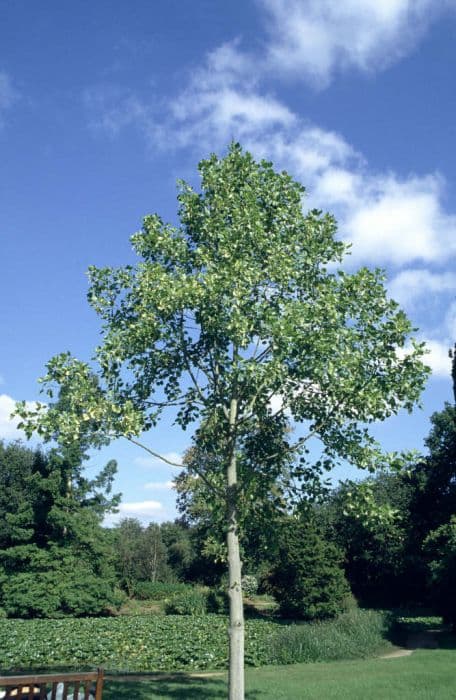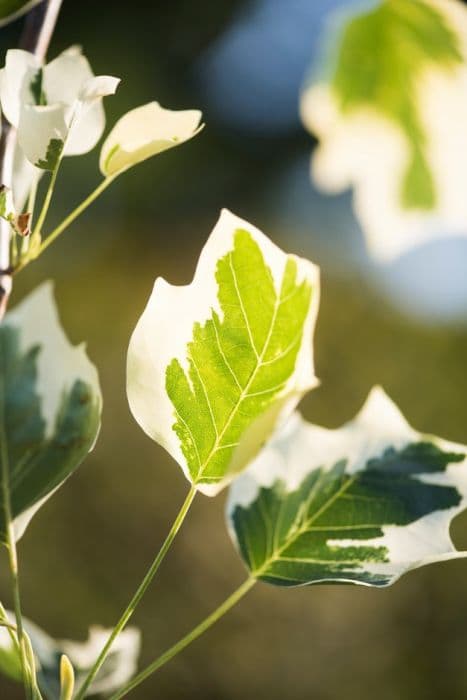Saucer Magnolia Magnolia × soulangeana 'étienne Soulange-bodin'

ABOUT
The Saucer magnolia is a breathtaking decidirectional and hybrid tree known for its stunning early spring blooms. It has large, cup-shaped flowers that can blend shades of pink, purple, and white, offering a striking contrast against its bare branches. These blooms emerge before the leaves do, making it one of the early color spectacles in a spring garden. Each flower is composed of broad, thick petals with a smooth outer surface, and they can often span several inches across, resembling a saucer, which inspires the tree's common name. After the flowers, the leaves appear, unfurling to a rich green hue and an oval to oblong shape. They offer a lush backdrop throughout the summertime. In the fall, the foliage might transition into golden yellows or bronzed tones before shedding for the winter. The textured bark of the tree provides winter interest with a grayish-brown color that appears furrowed and can be attractive when the branches are bare. Overall, the Saucer magnolia is cherished for its generous floral display that heralds the arrival of the warmer months, and its foliage that provides season-long interest. With careful cultivation, it can grace landscapes with its unique and alluring presence, though it remains modest in its growing requirements, often making it a preferred choice for gardeners looking to add a touch of magnificence to their spring gardens.
About this plant
 Names
NamesFamily
Magnoliaceae
Synonyms
Saucer Magnolia, Tulip Magnolia, Chinese Magnolia, Japanese Magnolia
Common names
Magnolia × soulangeana 'Étienne Soulange-Bodin'.
 Toxicity
ToxicityTo humans
The Saucer Magnolia is not considered toxic to humans. There are no significant toxic effects reported from ingesting any part of the plant.
To pets
The Saucer Magnolia is generally considered non-toxic to pets as well. It is not known to cause any significant toxic effects if pets ingest parts of the plant. However, it's always best to prevent pets from eating large amounts of any non-food plants as it may cause gastrointestinal upset or other non-toxic reactions.
 Characteristics
CharacteristicsLife cycle
Perennials
Foliage type
Deciduous
Color of leaves
Green
Flower color
Pink
Height
15-20 feet (4.5-6 meters)
Spread
10-15 feet (3-4.5 meters)
Plant type
Tree
Hardiness zones
4-9
Native area
China
Benefits
 General Benefits
General Benefits- Ornamental Value: Magnolia × soulangeana 'étienne Soulange-bodin', commonly known as Saucer Magnolia, has large, showy flowers that add aesthetic beauty to gardens and landscapes.
- Seasonal Interest: This magnolia provides year-round interest with its flowers blooming in spring, followed by attractive foliage in the summer, and textured seed pods in the fall.
- Shade and Shelter: The Saucer Magnolia offers shade and shelter with its spreading canopy, making it a suitable tree for creating cool, shaded areas in gardens and parks.
- Habitat for Wildlife: The tree provides a habitat and food source for birds and pollinators, such as bees and butterflies, which are attracted to its flowers.
- Low Maintenance: Once established, Saucer Magnolias require minimal maintenance, making them a good choice for both novice and experienced gardeners.
- Drought Resistance: The tree is relatively drought-tolerant, allowing it to thrive in areas with less rainfall once it has established a good root system.
- Variety of Landscapes: It can be used in diverse landscape settings, including urban gardens, parks, and as a specimen or accent tree due to its adaptable nature.
 Medical Properties
Medical PropertiesThis plant is not used for medical purposes.
 Air-purifying Qualities
Air-purifying QualitiesThis plant is not specifically known for air purifying qualities.
 Other Uses
Other Uses- Magnolia 'Soulange-bodin' petals can be pickled and used in salads or as garnishes, providing a unique flavor and attractive presentation.
- The wood from the magnolia tree is sometimes utilized in furniture making, offering a moderate hardness suitable for decorative items.
- Extracts from the flower buds are used in high-end perfumes, giving a luxurious and complex fragrance.
- Crushed magnolia leaves can be added to potpourris or used in scented sachets for their subtle, pleasant aroma.
- The fibers from the bark of magnolia trees can be used in the production of handmade paper, providing a distinctive texture.
- Dried magnolia flowers can be incorporated into candles to add a mild, sweet scent as they burn.
- The bark of the magnolia tree can be crafted into small decorative items or jewelry, often by artisans who specialize in natural materials.
- During blooming season, the flowers are sometimes used in photography or as a backdrop for special occasions because of their beauty and size.
- Some culinary enthusiasts use magnolia flowers to infuse syrups or vinegars, creating unique flavors for cooking and cocktails.
- Artists may use magnolia seed pods and cones as natural elements in crafting or as subjects for botanical illustrations.
Interesting Facts
 Feng Shui
Feng ShuiThe Saucer Magnolia is not used in Feng Shui practice.
 Zodiac Sign Compitability
Zodiac Sign CompitabilityThe Saucer Magnolia is not used in astrology practice.
 Plant Symbolism
Plant Symbolism- Perseverance: The Magnolia × soulangeana, commonly known as Saucer Magnolia, often symbolizes perseverance because it is one of the first trees to bloom in the spring, sometimes even before the frost has passed, demonstrating resilience and determination.
- Nobility: Due to its grandiose blooms and dignified presence, the Saucer Magnolia is frequently associated with nobility and dignity, reflecting elegance and splendor.
- Femininity: The soft and large petals of the Saucer Magnolia flowers are often viewed as a symbol of femininity, representing beauty and gentleness.
- Purity: The white color of some Saucer Magnolia blooms is traditionally seen as a symbol of purity and innocence.
 Water
WaterSaucer Magnolia should be watered deeply once a week during its growing season, especially if the weather is dry. The soil should be kept consistently moist but not soggy. Apply about 2 gallons of water for younger trees every time you water, slowly increasing the amount as the tree grows. During the winter or its dormant period, reduce watering frequency. It's crucial to water slowly at the base of the tree to allow deep penetration into the soil, promoting healthy root development.
 Light
LightSaucer Magnolia thrives best in full sun to partial shade. Ideally, it should receive at least 4 to 6 hours of direct sunlight per day. A spot that offers morning sun with some afternoon shade is perfect, protecting the tree from the intense heat of late-day sun while still providing the light it needs for healthy growth.
 Temperature
TemperatureSaucer Magnolia is hardy and can tolerate a range of temperatures; however, it prefers moderate conditions. Ideally, it grows best when temperatures are between 60°F and 70°F. The plant can survive minimum winter temperatures down to around 20°F but may be damaged if temperatures fall below this. Maximum summer temperatures should not consistently exceed 90°F for optimal growth.
 Pruning
PruningPrune Saucer Magnolia to remove damaged or diseased wood, to shape the plant, and to promote healthy growth. The best time for pruning is late winter or early spring, just after the risk of severe frost but before new spring growth begins. Light pruning can be done annually, but major pruning should be done sparingly and only as necessary.
 Cleaning
CleaningAs needed
 Soil
SoilSaucer Magnolia prefers well-drained, rich, and neutral to slightly acidic soil with a pH of 5.5 to 6.5. A mix of loam, compost, and leaf mold is ideal to provide the necessary nutrients and structure.
 Repotting
RepottingSaucer Magnolia trees, being large, are rarely repotted once planted in the ground; young potted trees may be repotted every 2 to 3 years to encourage growth.
 Humidity & Misting
Humidity & MistingSaucer Magnolia tolerates average outdoor humidity but does not require specific humidity conditions to thrive.
 Suitable locations
Suitable locationsIndoor
Ensure large space, bright indirect light, and consistent temperatures.
Outdoor
Plant in well-draining, fertile soil with sun to partial shade.
Hardiness zone
4-9 USDA
 Life cycle
Life cycleThe Saucer Magnolia (Magnolia × soulangeana 'Étienne Soulange-Bodin') begins its life cycle with germination from seed, typically requiring a period of cold stratification to break dormancy. After sprouting, the seedling grows into a juvenile tree, focusing on establishing a strong root system and foliage development. As it matures into an adult tree, it develops its distinctive woody structure and starts to produce the characteristic large, showy flowers in shades of white, pink, and purple, typically blooming in early spring before the leaves unfurl. Following the flowering stage, the tree sets fruit, which are cone-like aggregations of follicles containing seeds that are dispersed by the wind or animal agents. Throughout its life, the tree undergoes periods of growth and dormancy, responding to seasonal changes with the growth of new leaves in the spring and leaf abscission in the autumn. The Saucer Magnolia can live for many decades, continuing the cycle annually and slowly increasing in size and floral display as it ages.
 Propogation
PropogationPropogation time
Spring-Early Summer
Propogation: The most popular method of propagation for the Saucer Magnolia, or Magnolia × soulangeana 'Étienne Soulange-Bodin', is via hardwood cuttings. This is typically done in late fall or early winter when the tree is dormant. Cuttings should be about 6 to 12 inches (15 to 30 cm) long and include several nodes where leaves attach. The cut end is often dipped in a rooting hormone to encourage root development and then planted in a well-draining soil mixture. The pot with the cutting should be kept moist and in a sheltered location until roots have developed, which can take several months. Providing bottom heat of around 70°F (21°C) can improve the success rate of rooting. Once established with a robust root system, the new sapling can be transplanted outdoors to its permanent location.









